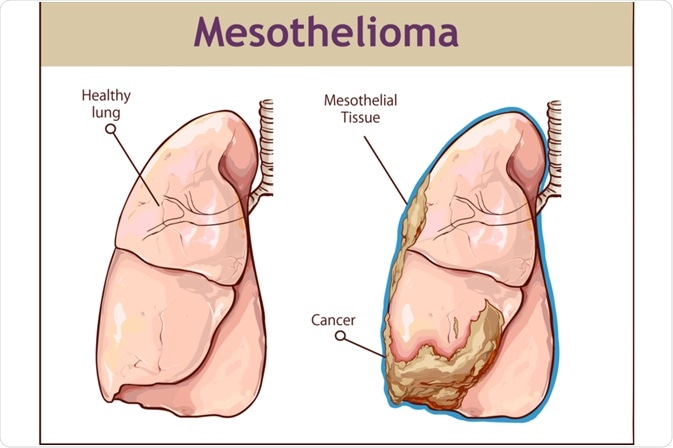Malignant mesothelioma, often shortened as mesothelioma, is a rare form of malignancy caused by exposure to asbestos. Asbestos are naturally occurring fiber-like minerals that have unique heat-resistant properties.

Image Credit: Drp8 / Shutterstock.com
During the first half of the twentieth century, this disease rose from obscurity to become a major occupational and public health problem at the end of the twentieth and the beginning of the twenty-first century.
The link between asbestos exposure and subsequent development of mesothelioma became well-established in 1960, and to date, it represents the most important occupational malignancy, apart from lung cancer, among industrial workers. Even though the mineral is rarely used today in most industrialized countries, the use of asbestos is still widespread in developing nations.
There is a prolonged time interval between the first inhalation of asbestos and the diagnosis of mesothelioma, generally in the range of 20 to 40 years. A myriad of different therapies has been tried in the past 50 years including surgery, radiotherapy, chemotherapy, immunotherapy, and, more recently, targeted therapy.
Types of mesothelioma
Mesothelial cells, which are a primary target in this disease, represent one layer of specialized, pavement-like cells that line the body's internal cavities and most organs. Although a cell layer formed by these cells, called the mesothelium, provides a protective and non-adhesive surface. The mesothelium also has a role in the transport of cells and fluids across the surface of the body wall and organs.
A malignant change in mesothelial cells and the mesothelium results in malignant mesothelioma. Mesothelioma is an aggressive tumor mainly of the pleural, but also the peritoneal and pericardial spaces. Although the condition is closely associated with exposure to asbestos, there are other factors that have a role in its pathogenesis, including certain genetic traits and even a viral agent known as the Simian virus 40 (SV40).
Malignant mesothelioma can be divided into three different types including epitheloid, sarcomatoid, and a mixture of both types, which is also called biphasic type. Between 50% and 70% of mesotheliomas are epitheloid, with cube-shaped and uniform cells. Sarcomatoid mesothelioma has its roots in supportive tissues like the bones, cartilage, or muscles, and occurs in 7% to 20% of cases. Mixed or biphasic type is found in 20-35% of cases with quite a dismal prognosis.
Disease course, management, and prognosis
Malignant pleural mesothelioma is most commonly presented with dyspnea and nonpleuritic chest wall pain, with at least one of these symptoms occurring in 60% to 90% of patients. These cardinal symptoms can also be associated with constitutional symptoms as well, especially weight loss, malaise, and occasional night sweats.
Frequent presenting radiologic findings include effusion, pleural masses, and pleural thickening. Computed tomography (CT) is more sensitive for determining the extent of the pleural abnormalities and involvement of adjacent structures. The pleural aspirate is an exudate with reduced glucose and pH levels. The diagnosis is confirmed with a biopsy and microscopic examination.
Life expectancy for diagnosed malignant pleural mesothelioma is usually poor, with median survival varying between 8 and 12 months, irrespective of the histologic type. After the introduction of cytoreductive surgery followed by intraperitoneal hyperthermic perfusion, a significant prolongation in the median survival has been achieved for malignant peritoneal mesothelioma, with almost half the patients alive at 5 years.
As novel agents are being explored for the disease, different combinations of therapies are being tried and novel biomarkers are being identified. Taken together, there is a reasonable expectation that the median survival rate in mesothelioma patients will increase in the years to come. Nevertheless, mesothelioma continues to be a very serious disease with a poor prognosis and low survival rates.
References
Further Reading
Last Updated: Apr 20, 2021